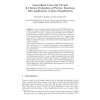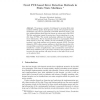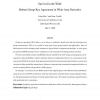107
click to vote
ICISC
2008
15 years 2 months ago
2008
Secure Evaluation of Private Functions (PF-SFE) allows two parties to compute a private function which is known by one party only on private data of both. It is known that PF-SFE c...
125
click to vote
ICISC
2008
15 years 2 months ago
2008
We propose a number of techniques for securing finite state machines (FSMs) against fault injection attacks. The proposed security mechanisms are based on physically unclonable fun...
122
click to vote
ICISC
2008
15 years 2 months ago
2008
Ciphertext-Policy Attribute-Based Encryption (CP-ABE) allows to encrypt data under an access policy, specified as a logical combination of attributes. Such ciphertexts can be decry...
105
click to vote
ICISC
2008
15 years 2 months ago
2008
Group key agreement (GKA) allows a set of players to establish a shared secret and thus bootstrap secure group communication. GKA is very useful in many types of peer group scenar...
124
click to vote
ICISC
2008
15 years 2 months ago
2008
Hardware implementations of cryptographic algorithms are still vulnerable to side-channel attacks. Side-channel attacks that are based on multiple measurements of the same operatio...
101
click to vote
ICISC
2008
15 years 2 months ago
2008
Relay attacks are one of the most challenging threats RFID will have to face in the close future. They consist in making the verifier believe that the prover is in its close vicini...
123
Voted
ICISC
2008
15 years 2 months ago
2008
We consider a visual secret sharing scheme with cyclic access structure for n secret images and n shares, where two consecutive shares decode one secret image. This secret sharing ...
110
click to vote
ICISC
2008
15 years 2 months ago
2008
Oblivious transfer is one of the most important cryptographic primitives, both for theoretical and practical reasons and several protocols were proposed during the years. We provid...
101
click to vote
ICISC
2008
15 years 2 months ago
2008
This paper proposes a novel technique, called instruction set limitation, to strengthen the resilience of software diversification against collusion attacks. Such attacks require a...
111
click to vote
ICISC
2008
2008
A New Technique for Multidimensional Linear Cryptanalysis with Applications on Reduced Round Serpent
15 years 2 months ago
Abstract. In this paper, we present a new technique for Matsui's algorithm 2 using multidimensional linear approximation. We show that the data complexity of the attack can be...



